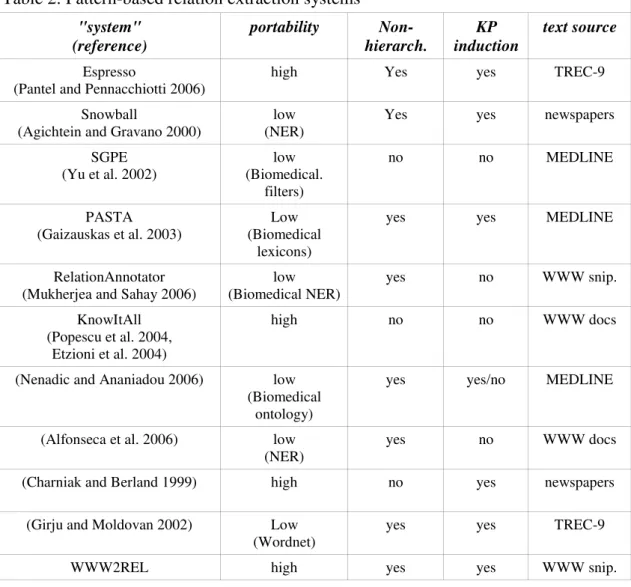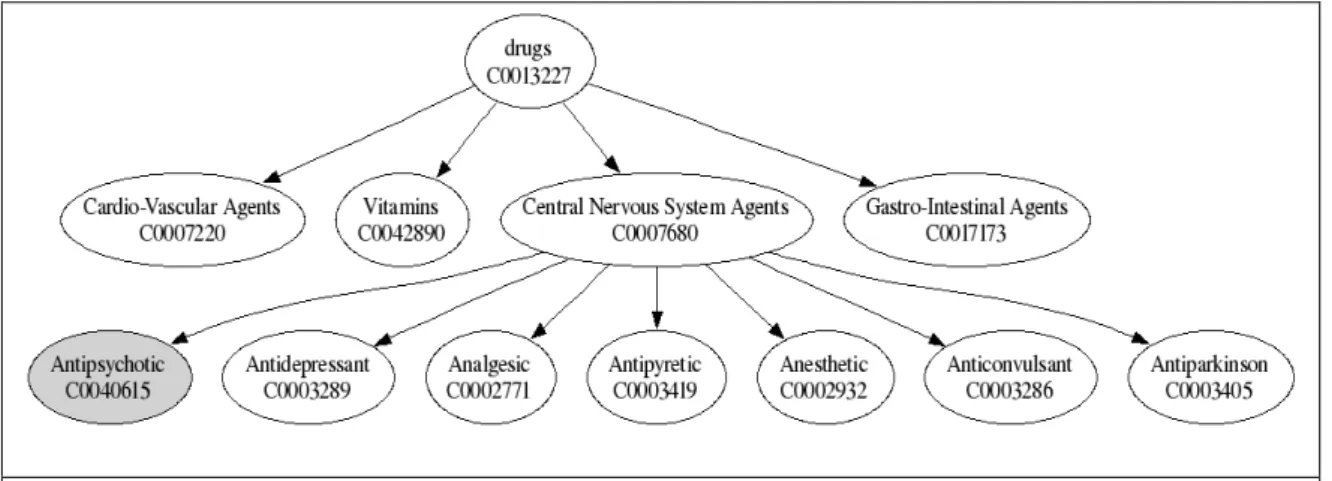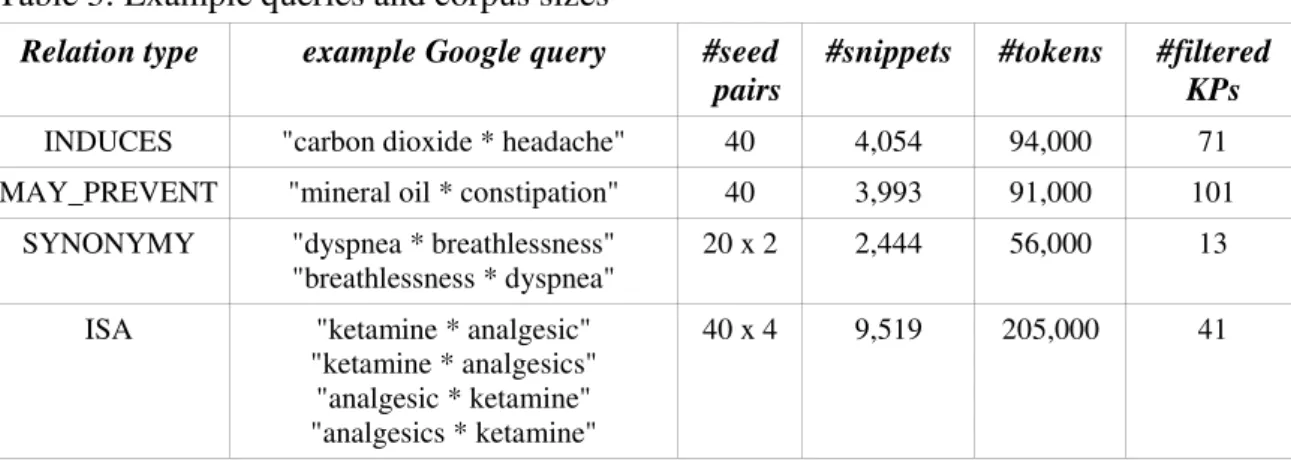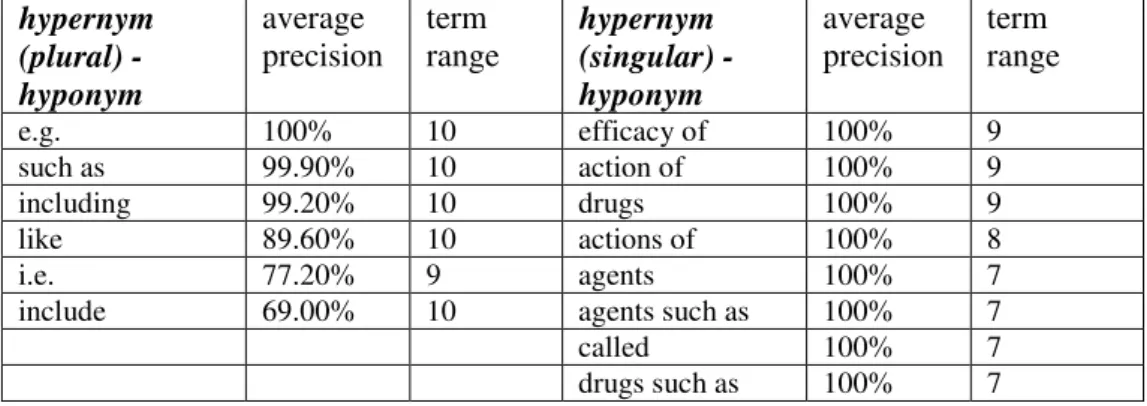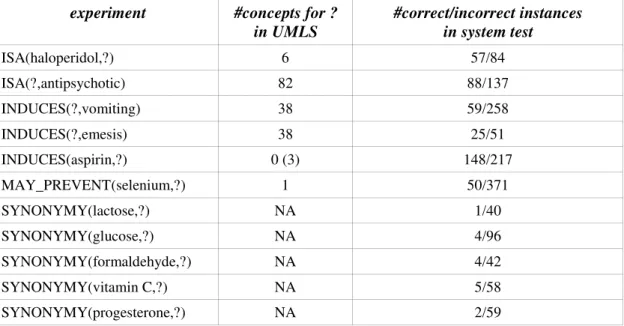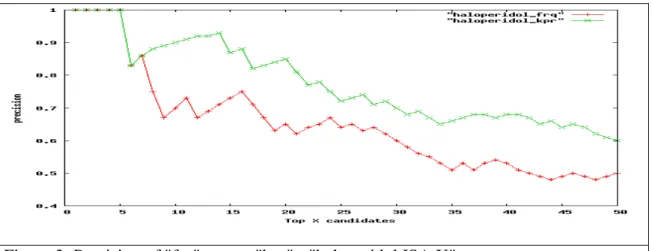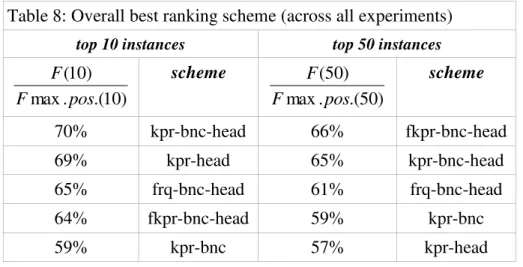Publisher’s version / Version de l'éditeur:
Terminology, 14, 1, pp. 20-44, 2008-08-01
READ THESE TERMS AND CONDITIONS CAREFULLY BEFORE USING THIS WEBSITE. https://nrc-publications.canada.ca/eng/copyright
Vous avez des questions? Nous pouvons vous aider. Pour communiquer directement avec un auteur, consultez la
première page de la revue dans laquelle son article a été publié afin de trouver ses coordonnées. Si vous n’arrivez pas à les repérer, communiquez avec nous à PublicationsArchive-ArchivesPublications@nrc-cnrc.gc.ca.
Questions? Contact the NRC Publications Archive team at
PublicationsArchive-ArchivesPublications@nrc-cnrc.gc.ca. If you wish to email the authors directly, please see the first page of the publication for their contact information.
This publication could be one of several versions: author’s original, accepted manuscript or the publisher’s version. / La version de cette publication peut être l’une des suivantes : la version prépublication de l’auteur, la version acceptée du manuscrit ou la version de l’éditeur.
For the publisher’s version, please access the DOI link below./ Pour consulter la version de l’éditeur, utilisez le lien DOI ci-dessous.
https://doi.org/10.1075/term.14.1.03hal
Access and use of this website and the material on it are subject to the Terms and Conditions set forth at Web-based extraction of semantic relation instances for terminology work
Halskov, Jakob; Barrière, Caroline
https://publications-cnrc.canada.ca/fra/droits
L’accès à ce site Web et l’utilisation de son contenu sont assujettis aux conditions présentées dans le site LISEZ CES CONDITIONS ATTENTIVEMENT AVANT D’UTILISER CE SITE WEB.
NRC Publications Record / Notice d'Archives des publications de CNRC: https://nrc-publications.canada.ca/eng/view/object/?id=d194bea3-1ac1-4102-a0df-43a9541130b0 https://publications-cnrc.canada.ca/fra/voir/objet/?id=d194bea3-1ac1-4102-a0df-43a9541130b0
Web-based extraction of semantic relation instances for
terminology work
Jakob Halskov and Caroline Barrière
This article describes the implementation and evaluation of WWW2REL, a domain-independent and pattern-based knowledge discovery system which extracts semantic relation instances from text fragments on the WWW so as to assist terminologists updating or expanding existing ontologies. Unlike most comparable systems, WWW2REL is special in that it can be applied to any semantic relation type and operates directly on unannotated and uncategorized WWW text snippets rather than static repositories of academic papers from the target domain. The WWW is used for knowledge pattern (KP) discovery, KP filtering and relation instance discovery. The system is tested with the help of the biomedical UMLS Metathesaurus for four different relation types and is manually evaluated by four domain experts. This system evaluation shows how ranking relation instances by a measure of "knowledge pattern range" and applying two heuristics yields an average performance of 70% to 65% of the maximum possible F-score by top 10 and top 50 instances, respectively. Importantly, results show that much valuable information not present in the UMLS can be found through the proposed method. Finally, the article examines the domain-dependence of different aspects of the pattern-based knowledge discovery approach proposed.
Key words: automatic extraction of linguistic patterns, UMLS ontology expansion, web-based semantic relation extraction
1 Introduction
With the digital revolution and the genesis of a vast and freely accessible repository of
text and knowledge known as the Internet, researchers from many fields, including text
mining and computational terminology, are struggling to overcome a major challenge of
the Internet Age, namely information overload. How does one find the gold nuggets of
generating or updating ontologies and terminological knowledge bases, an important
type of gold nuggets are semantic relations1 expressed explicitly in natural language strings. Such strings have been called knowledge-rich contexts (KRCs). A KRC has
been defined as:
A context indicating at least one item of domain knowledge that could be useful for conceptual analysis. In other words, the context should indicate at least one conceptual characteristic, whether it be an attribute or a relation. (Meyer 2001: 281)
Hearst (1992) originally presented a way of identifying semantic relations in text
by employing what has later been called knowledge patterns (Meyer 2001: 290),
knowledge probes (Ahmad and Fulford 1992) or explicit relation markers (Bowden et
al. 1996). In this article we will use the acronym KP for such patterns. For example, <to
treat> in the following example is a KP which establishes a causal MAY_PREVENT
relation between the two concepts represented by the terms selenium and cancer.
Revici was also an early advocate of using selenium <to treat> cancer.
KPs are used in pattern-based relation extraction systems which typically rely on
techniques resembling the Dual Iterative Pattern Relation Expansion (DIPRE) algorithm
introduced by Brin (1998) to extract, for example, instances of <company;location>
tuples directly from the WWW. The basic idea of DIPRE-like approaches is shown in
Figure 1: Dual Iterative Pattern Relation Expansion (DIPRE)
Figure 1. Dual Iterative Pattern Relation Expansion (DIPRE)
The intuition is that a small number of existing term pairs (seeds) instantiating
the target semantic relation type can be used to induce patterns which occur in the term
pair contexts, and these patterns can in turn be used to identify more term pairs and so
forth. As Table 1 illustrates, useful KPs may occur in either the left, middle or right
context of the term pair. Of course, KPs can also be discontinuous and span more than
one of these contexts. Following the results of Agichtein and Gravano (2000), which
show that the middle context is the most informative for English, we focus our first
exploration on this context. While exploring the left and right contexts would be
interesting, the fragmentary nature of the text snippets may render it difficult to extend
the methodology in these directions.
Table 1. Knowledge patterns in context
Table 1: Knowledge patterns in context
left term1 middle Term2 right
<causes of diarrhea include> parasites , some cancers ...
diarrhea <induced by> bacteria is a typical ...
to minimize the stomach irritation Aspirin <can cause>
As evidenced by Table 2, multiple pattern-based relation extraction systems
have been developed since Hearst (1992). The column entitled portability in this table,
which is by no means exhaustive, indicates the level of portability of the systems and
the information in the parentheses explains what might cause this to be low (for
example, the use of a biomedical Named Entity Recognition (NER) module). The
column entitled non-hierarch. indicates whether the system handles non-hierarchical
relation types, and KP induction indicates whether the patterns used by the system were
introspectively devised or induced automatically from text.
Table 2. Pattern-based relation extraction systems
Table 2: Pattern-based relation extraction systems "system" (reference) portability Non- hierarch. KP induction text source Espresso
(Pantel and Pennacchiotti 2006)
high Yes yes TREC-9
Snowball
(Agichtein and Gravano 2000)
low (NER)
Yes yes newspapers
SGPE (Yu et al. 2002) low (Biomedical. filters) no no MEDLINE PASTA (Gaizauskas et al. 2003) Low (Biomedical lexicons)
yes yes MEDLINE
RelationAnnotator (Mukherjea and Sahay 2006)
low (Biomedical NER) yes no WWW snip. KnowItAll (Popescu et al. 2004, Etzioni et al. 2004) high no no WWW docs
(Nenadic and Ananiadou 2006) low (Biomedical
ontology)
yes yes/no MEDLINE
(Alfonseca et al. 2006) low (NER)
yes no WWW docs
(Charniak and Berland 1999) high no yes newspapers
(Girju and Moldovan 2002) Low (Wordnet)
yes yes TREC-9
Table 2 reveals that many systems already make use of text on the WWW (e.g.,
Etzioni et al. 2004; Popescu et al. 2004; Alfonseca et al. 2006; Mukherjea and Sahay
2006), but most systems are custom-tailored to a specific domain, for example
biomedicine (e.g., Yu et al. 2002; Gaizauskas et al. 2003; Mukherjea and Sahay 2006;
Nenadic and Ananiadou 2006), or focus on the Information Extraction IE task of
extracting subclasses (e.g., Etzioni et al. 2004) or concept pairs which are "semantically
related" via unlabelled relations (e.g., Nenadic and Ananiadou 2006). However,
practical terminology work needs a wide range of labelled relations which may provide
essential conceptual characteristics to be used in the writing of definitions.
This article thus describes the implementation and evaluation of WWW2REL, a
relation extraction system which:
1. uses the WWW both for discovering KPs and relation instances;
2. can be applied to new domains;
3. can be applied to extract instances of any semantic relation type.
The combination of the three characteristics makes the system rather unique
when compared to the systems listed in Table 2. It shares many features with the
Espresso system, but uses the WWW rather than a controlled text source (TREC-9
competition). While section 2 discusses in more detail the properties of KPs, section 3
outlines the KP discovery and filtering step of WWW2REL. Section 4 describes the
extraction of relation instances, and section 5 evaluates the performance of both
individual ranking schemes but also of the system overall. Finally, portability issues are
discussed in section 6, and section 7 summarizes our conclusions.
2 A closer look at KPs
landmark article, Meyer (2001) lists the following challenges to using KPs in automatic extraction tasks: 1. Unpredictability; 2. Polysemy; 3. Anaphoric reference; 4. Domain-dependence.
That KPs are unpredictable simply reflects the fact that they are part of natural
rather than controlled or artificial language. There is virtually no limit to the creativity
with which human beings express themselves, even when conveying specialized
knowledge to each other. The polysemy, or ambiguity, of KPs is another fascinating
feature of natural language (or annoying depending on the perspective). However, by
using a reliability measure like KP range (to be described in section 4.1) it is possible to
reduce the adverse effect of individual KP polysemy. Anaphoric reference is a third
feature of natural language, notorious for its complexity and a hard nut to crack for
natural language processing (NLP) applications. Resolving anaphora is a matter of
boosting recall, and in the present implementation of WWW2REL this is not attempted
because there is plenty of data to process (the entire WWW) and it makes sense to adopt
a text mining approach. Finally, the possible domain-dependence of KPs will be
addressed in section 6 of this article.
We suggest viewing the challenges of working with KPs in terms of the quality
conditions these KPs should have, mainly:
1. High precision;
2. High recall;
Striking the perfect balance between high recall, high precision and high
portability can be hard, and also depends on the purpose of the application. However, to
some extent the parameters are interdependent in that high precision KPs may tend to be
domain-dependent and thus have a low portability and a low recall (at least in other
domains than the one for which they were discovered). Conversely, highly portable KPs
will tend to have a high recall and, presumably, a somewhat lower precision. Therefore
the "discovery power" of individual KPs is likely to differ greatly.
For our application, WWW2REL extracts relation instances directly from the
entire WWW and presents these to the user as ranked by their assessed reliability, so
from a pragmatic viewpoint we favour precision and portability over recall even if we
will later present a classical evaluation in terms of precision and recall.
In terms of precision-related challenges at least four noise-causing factors can
occur when relying on KPs to extract relation instances automatically from text:
1. The KP does not instantiate a semantic relation at all.
2. The KP instantiates a different semantic relation than the target one.
3. The KP instantiates the target semantic relation, but its arguments do not represent
domain-specific concepts and are not terminologically interesting.
4. The KP instantiates the target semantic relation, its arguments are domain-specific,
but it is not sure that the relation holds between its arguments.
An example of the first cause of noise is the following sentence from a paper in
a back-issue of The Computer Journal.2
What <is a> deep expert system?
The pattern <is a>, which might in other cases establish a hyponym-hypernym link,
hypernym of the concept represented by deep expert system.
The second factor causing noise can be illustrated by the pattern <arise from> in
the following sentence from a glossary of medical terms from the New York
Presbyterian Hospital.3
Schwannomas and neurofibromas, tumors that <arise from> the sheaths that cover nerves and improve the conduction of nerve impulses.
In general language arise from will almost always (except for poetic language, perhaps)
be used to establish cause-effect relations, but in this case, however, it instantiates a
locative relation between tumors and sheaths.
As for the third cause of noise, a more recent issue of The Computer Journal4 provides another example.
We agree that this semantic decoupling <can cause> problems, although the degree of problems depend on the power of the weaving language and how it is used.
This time the KP <can cause> does establish a causal link, but one argument (problems)
is of such a general nature that the instance will presumably not be useful for
terminologists who work bottom-up modelling the knowledge of special domains, or
even sub-domains. This third cause of noise is perhaps the hardest to identify and
evaluate, because the line between fuzzy categories and domain-specific concepts can
be difficult to draw. Thus when extracting semantic relation instances for terminology
an important subtask is automatic term recognition (ATR) which is typically achieved
by a combination of linguistic and statistical techniques. WWW2REL includes a simple
ATR technique to be described in section 4.2. (For more on ATR the reader may consult
e.g., Drouin 2003.)
Finally, the fourth cause of noise is particularly relevant when using the WWW
encounter many incorrect semantic relations, but when authorship, text type and many
other important quality parameters are unknown, it is not totally inconceivable that
some relation instances will simply be false. The following is an example from a
SYNONYMY experiment carried out as part of the WWW2REL evaluation.
1000mg of vitamin c, <aka> Ester C, if you feel a cold or flu coming on.
Since ester c is a modified (chemically enhanced) form of vitamin c, the SYNONYMY
relation established by the KP <aka> is incorrect. The informal acronym for also known
as, of course, signals that the communicative setting may not be an academic one,
which could be one reason (but not a sufficient one) to have doubts about the authority
of the source. This, of course, raises the question whether the advantages of using the
entire web as a specialized corpus are not outweighed by disadvantages such as the
retrieval of spurious instances like the above. Since the web is dynamic,
multidisciplinary, multilingual, omnipresent and freely available, the authors find that
the benefits outweigh the challenges. Admittedly, spurious relation instances may be
more of a challenge in domains heavily affected by de-terminologization (Meyer and
Mackintosh 2000).
Although we are aware of the different sources of noise, they will not be
differentiated in our system analysis as the human evaluation in section 5 will not
distinguish between them. Most of our filtering approaches will target noise reduction in
general rather than particular types of noise. When a particular approach (such as the
BNC heuristic discussed later) focuses on a particular type of noise, this will be
highlighted. We postpone the discussion on the portability issue to section 6.
3 Discovering and filtering KPs
must be filtered to find “good” KPs given all the noise issues mentioned in section 2. The first step is to select a small number of seed term pairs instantiating the
target relation types. In the experiments four relation types are selected, two classical
ones (ISA and SYNONYMY) and two relations important in biomedicine
(MAY_PREVENT and INDUCES). All term pairs are randomly extracted from the
Unified Medical Language System (UMLS) Metathesaurus which is freely available at
http://umlsks.nlm.nih.gov (the 2006AB edition is used in the experiments). Figure 2
illustrates how seed term pairs for the ISA relation are extracted from a small fragment
of the UMLS saving the concept Antipsychotic for the system evaluation.
Figure 2: Using information in UMLS to discover KPs and augment UMLS
Figure 2. Using information in UMLS to discover KPs and augment UMLS
Google queries like the ones listed in Table 3 are then used to download the top
100 text snippets for each of the seed term pairs and thus compile four corpora of term
pairs in context. The * is a word wildcard representing at least one word. As can be seen
from the number of text snippets and tokens in each corpus, KP discovery is based on
very small amounts of data. For SYNONYMY and the ISA relation additional query
analgesics <such as> ketamine, but ketamine <is an> analgesic. Table 3. Example queries and corpus sizes
Table 3: Example queries and corpus sizes
Relation type example Google query #seed pairs
#snippets #tokens #filtered KPs
INDUCES "carbon dioxide * headache" 40 4,054 94,000 71 MAY_PREVENT "mineral oil * constipation" 40 3,993 91,000 101
SYNONYMY "dyspnea * breathlessness" "breathlessness * dyspnea"
20 x 2 2,444 56,000 13
ISA "ketamine * analgesic" "ketamine * analgesics"
"analgesic * ketamine" "analgesics * ketamine"
40 x 4 9,519 205,000 41
For the two causal relations, inversing the term pairs would have led to the
discovery of passive voice KPs. However, we decided to ignore those due to data
sparseness. Although the WWW is vast, specialized biomedical term pairs co-occur
relatively infrequently in themselves, and with the added restriction that they be
connected with a passive verb phrase there was insufficient data to reliably discover
KPs, especially for the MAY_PREVENT relation. For SYNONYMY and the ISA
relation inversing argument order did not cause data sparseness.
The arbitrary number of 40 seed pairs for each relation was determined by the
fact that for the INDUCES relation only 40 different UMLS term pairs co-occurred
frequently enough on Google to meet the target of retrieving the top 100 text snippets
for each pair. It is an interesting question whether a lower number of seed term pairs
would reduce system performance at the stage of KP discovery and filtering. In most
cases an equal amount of text snippets could presumably be retrieved simply by
increasing the number of snippets downloaded for each term pair. However, the KP
effective the higher the number of seed pairs.
In order to reduce the set of KPs and eliminate noisy patterns induced from the
Google text snippets, three strategies were developed:
1. Forcing a verb in the KP;
2. Assessing KP precision using negative term pairs;
3. Measuring the KP "term range."
The rationale for the first strategy is provided by studies like Barrière (2001)
who empirically establishes that verbs are the most reliable form of KP. However, this
first strategy might be too restrictive for certain relations, such as SYNONYMY and
ISA. For example, it would eliminate perfectly valid KPs like <such as> and <or other>.
The second strategy is inspired from the Q-fold cross-validation technique used
in machine learning. We split the positive pairs in 10 groups. We always look at the
KPs found (learned) from 9 groups out of the 10 and test on the 10th group. This process is repeated 10 times to average the results. Each time, for all the learned KPs, we
measure their precision by counting how often they occur with the positive pairs (pairs
expressing the desired relation) in the 10th group versus a set of negative pairs (pairs expressing a different relation) of equal size. The Google hit counts for all <t1,KP,t2> triplets (the numerators in the equation below) are normalized by taking into
consideration how often the term pairs themselves co-occur on Google, i.e.
CGoogle(t1,*,t2). 4 1 1, 2, , 2 , 1 , 2 , 1 4 1 1, 2, , 2 , 1 , 2 , 1 4 1 1, 2, , 2 , 1 , 2 , 1 ) ,*, ( ) , , ( ; ) ,*, ( ) , , ( ; ) ,*, ( ) , , ( ; ) ( n Google n n n n Google neg n n n Google n n n n Google pos n n n Google n n n n Google pos n n t t C t KP t C R t t t t C t KP t C R t t t t C t KP t C R t t KP prec
iterations. While Rpos is a set of four positive term pairs for the target relation in a particular iteration, Rneg is a set of four negative term pairs in that same iteration. The negative pairs are selected at random from the UMLS Metathesaurus, but so that they
represent semantically similar relation types and co-occur relatively frequently on the
WWW (a minimum threshold of 15,000 hits was established empirically). An example
of a negative pair for SYNONYMY is "cystic fibrosis;lung disease" which in fact
represents an ISA relation.
The third strategy, KP term range, is in fact a by-product of the 10-fold
cross-validation described above. It is to be understood as the number of iterations (i.e.,
groups of different term pairs) in which a particular KP candidate occurs. As much as
the second strategy is meant to ensure that a KP is associated with a particular relation,
the third strategy ensures that a KP is used often enough, with many different pairs to be
relation-dependent and not pair-dependent.
The three filters are independent and can be activated or not depending on the
semantic relation investigated. In our particular experiments, the verb filter was
activated for the causal relations, and since this seemed highly effective, the term range
filter was only activated for ISA and SYNONYMY. The precision filter was turned on
for all semantic relations. Some thresholds were also set empirically and deserve further
investigation in future work. The minimum average precision threshold was set to 50%
and minimum term range to 4. The result of applying the different filters is four reduced
sets of KPs, one for each relation studied. No attempt is made at generalizing the KPs,
which is a popular way of boosting recall on small data sets. When using an unbounded
and uncategorized text source, however, generalizing KPs might prove counter
Table 4A. Example KPs for SYNONYMY, MAY_PREVENT and INDUCES
While Table 3 gives the total number of KPs (surviving the filtering) for each
relation type, Table 4A gives actual examples of these KPs for the three relations of
SYNONYMY, MAY_PREVENT and INDUCES.
Finally, Table 4B provides examples of the filtered ISA KPs as grouped by the
four query variations or templates (see Table 3). While many of the ISA KPs in Table
4B may appear familiar and domain independent, quite a few seem specific to the
biomedicine domain and would appear to have a low portability (e.g. "properties of",
"efficacy of"). We discuss this further in section 6 with a small experiment which
attempts to assess the portability of all KPs by applying them to another domain.
Table 4B. Example KPs for ISA
Table 4B: Example ISA KPs (by template) with average precision > 50% and "term range" > 4
hypernym (plural) - hyponym average precision term range hypernym (singular) - hyponym average precision term range e.g. 100% 10 efficacy of 100% 9 such as 99.90% 10 action of 100% 9 including 99.20% 10 drugs 100% 9 like 89.60% 10 actions of 100% 8 i.e. 77.20% 9 agents 100% 7
include 69.00% 10 agents such as 100% 7
called 100% 7
drugs such as 100% 7
Table 4A: Example KPs with average precision > 50% and "term range" > 4 (SYNONYMY) or "forced verb" (the two causal relations)
SYNONYMY MAY_PREVENT INDUCES
KP KP KP
or (10) prevents induces
see (9) reduces does not cause
also known as (9) to prevent can cause
ie (9) prevent to induce
means (8) in preventing Induced
also called (8) had Include
acute (7) prevented to cause
called (6) decreases causes
aka (6) to treat produces
is also called (5) reduced may cause
properties of 100% 7 effects of 100% 10 ... ... ... hyponym- hypernym (singular) hyponym- hypernym (plural)
exerts its 100% 9 and other 99.01% 10
as an 100% 9 or other 69.48% 10
is an 100% 10 other 68.38% 10
is an effective 100% 10 with other 67.60% 10
an 99.96% 10 see 59.15% 10 has 89.57% 10 as 58.84% 10 is a new 79.83% 10 is 76.72% 10 a new 69.65% 10 as 63.94% 10
We do not perform a manual evaluation of the resulting KP lists, but rather
proceed to an indirect evaluation by assessing their usefulness in the task of relation
instance finding (what they were discovered for in the first place). We can see from
Table 4B that some KPs (such as <is> or <is a>) are probably not too reliable in
isolation, but if used in combination with other KPs (as we will see in the next section)
they could prove useful. Certainly in an interactive system, we can imagine that a user
could turn on/off the different KP filters (verb, precision, term range) and adjust the
thresholds for each filter depending on the resulting lists obtained for diverse semantic
relations and domains of interest. Also, future work will include a more in-depth
assessment of the impact of changing the threshold values.
4 Extracting and ranking instances
For any semantic relation, after a set of KPs is established as described in the previous
section, we can discover new relation instances on the WWW by selecting an input
term, leaving one argument blank and forming new Google queries based on the
template, "<input term> <KP> <NP>."
or symptoms from the UMLS Metathesaurus (e.g. aspirin, lactose, vomiting), KP
belongs to P, P being the set of filtered patterns discovered for the target relation type,
and NP represents a sequence of NP chunk elements produced by tagging and chunking
the Google snippets using Treetagger5 and Yamcha.6 For each of the KPs in P the top 100 snippets are returned. For example, in the "aspirin <INDUCES> X" experiment a
maximum of 7,100 snippets may be returned as 71 KPs were discovered for this relation
type.
4.1 Reliability measures
Four reliability measures are currently implemented in WWW2REL and are used to
rank relation instances returned by the system. The measures are listed below.
1. frq(NP) = P KP Csample(t,KP,NP) 2. kpr(NP) = KP P| (t,KP,NP) 3. fkpr(NP) = frq(NP)*kpr(NP) 4. pmi(NP) = | | ) `( * max ) , , ( P KP r NP KP t pmi pmi P KP
The first measure, frq(NP), is a baseline ranking scheme in which the instances,
or NPs, are simply ranked by their total co-occurrence frequency with the input term, t,
and all KPs in the set of patterns, P, known by the system for the target relation type.
The second measure, kpr(NP), ranks NPs by the range of different KPs with
which they occur in the sample. This will provide evidence that a suggested instance is
expressed in different ways in the corpus. The third measure, fkpr(NP), is a hybrid of
the two previous measures devised in an attempt at combining their strength.
instance reliability measure, r(i), from the Espresso system (Pantel and Pennacchiotti
2006) in which a continuous KP reliability scale, r(KP), is used. In WWW2REL, r`(KP)
is either 0 or 1 depending on whether the KP met the threshold values in the filtering
stage. In the equation, pmi(t,KP,NP) is approximated by Google hit counts:
) ,*, ( * ,*) (*, ) , , ( NP t C KP C NP KP t C Google Google Google 4.2 Heuristics
In addition to the four reliability measures, two heuristics are devised to help ranking
the relation instances: BNC (British National Corpus) discounting and head grouping.
The BNC discounting heuristic is inspired by a statistical automatic term
recognition technique commonly used in computational terminology, namely comparing
the relative frequencies of a term candidate in a general language reference corpus
versus the analysis corpus to compute a "weirdness" measure (Ahmad 1993). As
"weirdness" is biased towards rare events, however, the heuristic in WWW2REL simply
penalizes NPs whose head is too general and thus likely to be terminologically
irrelevant. The BNC is used as model of general language, and the following formula
illustrates how BNC filtering is applied to the "kpr" ranking scheme.
)) ( log( ) ( ) ( head BNC bnc NP C NP kpr NP kpr
The head noun grouping heuristic basically groups all instances by their NP head
and executes a primary ranking of these heads based on the particular ranking scheme,
e.g., "kpr." Using the same scheme all NPs sharing a particular head are then ranked.
That grouping instances by their head noun could be a useful strategy for boosting
performance will be illustrated by the example system output in section 5.3.
In this section, we attempt to measure the performance of WWW2REL at the task of
knowledge discovery. The instance ranking approaches described in section 4 will be
compared against a gold standard established by humans by using typical information
retrieval measures, namely precision, recall and F-score (a combined measure). The
section first discusses the evaluation setup and the issue of inter-annotator agreement. It
then gives an example of system output and determines which relation instance ranking
configuration yields the overall best performance. Finally, it examines to what extent
the system can indeed augment the UMLS Metathesaurus.
5.1 Setup and purpose
As WWW2REL is essentially a knowledge discovery system which finds relation
instances not recorded in the starting ontology, no existing gold standard can be used for
evaluation. Although it is impossible to assess recall when looking for new knowledge
on the WWW, a gold standard can be established by running the system for all the
different experiments without any kind of instance ranking or filtering. Four experts are
then asked to manually evaluate the correctness of each instance thus producing,
themselves, a gold standard from unfiltered system output. All experts are young female
graduates of the Danish University of Pharmaceutical Sciences (www.dfuni.dk). In total
approximately 2,000 instances are assigned one of the following three judgments by
each expert:
1. Relation instance is correct AND argument is domain-specific;
2. Unsure OR argument is fuzzy/vague;
3. Relation instance is incorrect.
In the gold standard, instances scoring an average judgment less than or equal to
correct and one considers it incorrect, the system regards it as correct as (1+1+1+3)/4 is
1.50. When measuring system performance in terms of F-score, it is important to stress
that recall is not to be understood in an absolute sense but only with respect to the
number of relation instances in the samples retrieved by the system and receiving an
average judgement of 1.50 or less.
Table 5. Experiments, recorded concepts in UMLS and correct instances in WWW2REL output
Table 5: Experiments, recorded concepts in UMLS and correct instances in WWW2REL output
experiment #concepts for ? in UMLS #correct/incorrect instances in system test ISA(haloperidol,?) 6 57/84 ISA(?,antipsychotic) 82 88/137 INDUCES(?,vomiting) 38 59/258 INDUCES(?,emesis) 38 25/51 INDUCES(aspirin,?) 0 (3) 148/217 MAY_PREVENT(selenium,?) 1 50/371 SYNONYMY(lactose,?) NA 1/40 SYNONYMY(glucose,?) NA 4/96 SYNONYMY(formaldehyde,?) NA 4/42 SYNONYMY(vitamin C,?) NA 5/58 SYNONYMY(progesterone,?) NA 2/59
Table 5 lists the total of eleven different input terms used to test the performance
of WWW2REL on the four different relation types. The numbers in the second column
indicate how many concepts are already recorded in the UMLS Metathesaurus for each
experiment. For the five SYNONYMY experiments NA indicates that this number is
irrelevant when looking for synonyms of the same concept. The third column indicates
how many positive and negative instances were found in the gold standards established
KPs found for each semantic relation was different, (b) the number of instances found
for each KP was different (with a maximum of 100) and (c) the number of instances
annotated by the four judges varied as well.
As regards INDUCES(apirin,?) there are zero concepts recorded in the UMLS
for ?. However, 3 concepts are recorded for the highly similar relation type
HAS_PHYSIOLOGIC_EFFECT. Since we wish to investigate the INDUCES relation
in its broader CAUSES sense, it would arguably be unfair not to consider these 3
concepts as well. Nevertheless, Table 5 suggests that a knowledge discovery process
could indeed be useful to augment information in the UMLS Metathesaurus. This is
especially the case for the two experiments involving aspirin and selenium.
Admittedly, the input terms represent a limited range of concepts, namely
mainly drugs or substances with the exception of a single sign or symptom (i.e.
vomiting/emesis). Future work should investigate input terms representing more diverse
concepts.
5.2 Interannotator (dis)agreement
With four domain experts judging the correctness of the same relation instances, it is
relevant to examine to what extent these experts are in agreement across all
experiments. There are multiple measures of inter-annotator agreement, including joint
probability, correlation coefficients and the kappa measure. Fleiss kappa measure
(Fleiss 1971) is used in this case because it takes into account the amount of agreement
expected to occur by chance and also works for more than just two annotators as
opposed to Cohen's kappa (Cohen 1960). It is defined as
e e P P P k 1 where the
numerator expresses the degree of agreement actually achieved and the denominator the
From the kappa values in Table 6 it is apparent that, overall, the four experts had a
higher degree of agreement in experiments involving SYNONYMY and the ISA
relation than in the case of the two causal relations. In particular, assessing the
correctness of system proposals for positive effects of selenium seemed to cause the
experts considerable trouble. Private talks with the experts revealed that a range of
possibly beneficial physiological effects of selenium intake have been proposed, but
that there is scientific agreement on the correctness of only a very few of these effects.
Also, applying WWW2REL to find entities which induce vomiting resulted in the
lowest inter-annotator agreement of all experiments. This is due to the much greater
search space of the WWW which causes the results to contain many instances of the
target relation which are correct but whose arguments are judged to be too general and
thus irrelevant to the domain (e.g., too much chocolate <can cause> vomiting). As
indicated by the kappa values in the Table 6, however, exchanging vomiting by the
more technical (domain-specific) synonym emesis doubled inter-annotator agreement.
Table 6. Inter-annotator agreement across all experiments
Table 6: Inter-annotator agreement across all experiments No. Experiment kappa observations
1 SYNONYMY(formaldehyde,?) 0.75 46 2 ISA(?,antipsychotic) 0.62 225 3 ISA(haloperidol,?) 0.57 141 4 SYNONYMY(lactose,?) 0.57 41 5 SYNONYMY(glucose,?) 0.56 100 6 SYNONYMY(vitamin C,?) 0.45 63 7 INDUCES(?,emesis) 0.42 76 8 SYNONYMY(progesterone,?) 0.40 61 9 INDUCES(aspirin,?) 0.28 365 10 MAY_PREVENT(selenium,?) 0.28 421 11 INDUCES(?,vomiting) 0.23 317
5.3 Example output
Table 7. "Aspirin <INDUCES> X" - top 10 candidates
Table 7: "Aspirin <INDUCES> X" – top 10 candidates Ran
k
candidate ("frq")
judges avg. candidate
("fkpr-bnc-head")
judges avg.
1 apoptosis 1,1,2,1 1.25 bleeding 1,1,2,2 1.5
2 bleeding 1,1,2,2 1.5 gastrointestinal bleeding 1,1,1,1 1.0
3 asthma 1,1,2,1 1.25 stomach bleeding 1,1,1,1 1.0
4 ulcers 1,2,2,1 1.5 more bleeding 1,1,2,3 1.75
5 ringing 1,2,2,3 2.0 internal bleeding 1,1,2,1 1.25
... ... ... ... ... ... ...
Table 7 provides an example of system output given the input term aspirin and the set
of KPs discovered for the INDUCES relation. On the left hand side, candidate instances
are ranked by simple frequency in the corpus of Google text snippets (baseline "frq"),
but on the right hand side ranking is done by the "fkpr" scheme with the two heuristics
turned on (described in section 4). The main advantage of the "fkpr-bnc-head" ranking
appears to be that its head grouping helps to cluster information on synonyms and
hyponyms, which is useful to terminologists. Depending on the application, we could
also view the diversity offered by the top ranking candidates on the left of the table
("frq") as quite informative to the terminologist although somewhat noisier. If equipped
with a simple graphical user interface, WWW2REL could make it possible for
terminologists to switch back and forth between viewing only candidate heads and
viewing all candidates sharing a particular noun head.
5.4 Performance of ranking schemes
As illustrated by Figure 3, simply ranking relation instances by their frequency is indeed
a suboptimal, baseline strategy. The main weakness of the "frq" scheme is that it
Figure 3: Precision of "frq" versus "kpr" - "haloperidol ISA X"
Figure 3. Precision of "frq" versus "kpr" - "haloperidol ISA X"
Presented with a wide range of relation instance ranking schemes applied to a
number of different experiments, the intended users of the system are likely to request a
default setting which will produce the overall best results. The average performance of
the individual schemes across all experiments and all relation types can be computed as
the proportion between actual F-score and the maximum possible F-score at a uniform
cut-off point of e.g., the top 10 and top 50 instances, respectively. In the "aspirin
INDUCES X" experiment the maximum possible F-score by the top 50 instances is
given by: 51 . 0 148 50 50 50 148 50 * 50 50 * 2 ) 50 ( . . max pos F
as there are a total of 148 correct instances in this experiment.
Table 8. Overall best ranking scheme (across all experiments)
Table 8: Overall best ranking scheme (across all experiments) top 10 instances top 50 instances
) 10 .( . max ) 10 ( pos F F scheme ) 50 .( . max ) 50 ( pos F F scheme
Table 8: Overall best ranking scheme (across all experiments) top 10 instances top 50 instances
) 10 .( . max ) 10 ( pos F F scheme ) 50 .( . max ) 50 ( pos F F scheme 70% kpr-bnc-head 66% fkpr-bnc-head 69% kpr-head 65% kpr-bnc-head 65% frq-bnc-head 61% frq-bnc-head 64% fkpr-bnc-head 59% kpr-bnc 59% kpr-bnc 57% kpr-head
We can now measure the average performance of each possible ranking configuration
across all eleven experiments by computing
n i F i F n e 1 max.pos.() ) ( where e is a counter
representing the individual experiments, n=11, and the number of instances, i, is either
10 or 50. From the average performance scores in Table 8 it is apparent that the best
configurations are those in which both heuristics, i.e. head grouping ("head") and BNC
discounting ("bnc"), are activated. It also appears that ranking instances by their KP
range results in the best overall performance (cf. "kpr-bnc-head"), even if the fkpr
scheme is slightly better when considering the top 50 instances.
5.5 Augmenting the UMLS
This section examines more closely the usefulness of WWW2REL towards augmenting
an existing terminological resource, namely the UMLS Metathesaurus upon which the
system was trained and tested in the previous sections. It is no trivial matter to
automatically measure the proportion of "new" or unrecorded, knowledge retrieved.
While instances which differ only in terms of non-essential adjectival modifiers (e.g.,
bleeding vs. severe bleeding) should arguably not be counted as pieces of new
bleeding) is perhaps another matter. Moreover, technical issues like ensuring a reliable
automatic decomposition of NPs containing conjunctions or disjunctions may disturb
the picture. For these reasons the proportion of new knowledge retrieved by
WWW2REL was manually computed based on the following guidelines.
1. Novelty by means of non-essential adjectival modifiers is ignored; 2. Novelty through conjunction, disjunction and/or ellipsis is ignored; 3. Novelty by means of synonymy is accepted.
Table 9. New knowledge retrieved by WWW2REL
Table 9: New knowledge retrieved by WWW2REL experiment % of correct
instances not in UMLS
examples of unrecorded, correct instances
MAY_PREVENT(selenium,?) 100% lung cancer risk, DNA damage ...
INDUCES(aspirin,?) 100% ulcers, stomach irritation ...
INDUCES(?,vomiting) 95% meningitis, overeating ...
INDUCES(?,emesis) 96% apomorphine, carboplatin, cisplatin...
ISA(haloperidol,?) 69% CNS-depressant drug ...
ISA(?,antipsychotic) 39% amisulpride, bretazenil, fluoxetine ...
SYNONYMY(lactose,?) 100% milk sugar
SYNONYMY(glucose,?) 33% corn sugar
SYNONYMY(formaldehyde,?) 20% metylene oxide
SYNONYMY(progesterone,?) 100% progestin, progestogen
SYNONYMY(vitamin c,?) 33% ascorbate
Observing these three principles, Table 9 lists the proportion of all correct
instances returned by WWW2REL for each experiment but not recorded in the UMLS.
Looking at the percentages in Table 9 (and the number of positives in Table 5)
we see that new instances are primarily retrieved for the causal relation types. Indeed,
nearly 100% of all causal instances judged to be correct by the experts are not recorded
in the UMLS. For the ISA relation the proportion of new knowledge is somewhat lower,
relatively high proportion of unrecorded hypernyms proposed for haloperidol (69%),
this can be explained by the fact that quite a few of these hypernyms (e.g., medication
or medicine) are so superordinate that they are on the point of being terminologically
irrelevant and thus do not really augment the UMLS.
With the two exceptions of progesterone and lactose, the proportion of new
knowledge is considerably lower in the SYNONYMY experiments. One reason is that
the number of synonyms for a particular concept is much lower, and presumably also
more fixed, than e.g. the number of new drugs of a particular category or the number of
side effects discovered for a particular drug.
The results in Table 9 speak for themselves and show how knowledge not
included in the UMLS can be semi-automatically discovered on the WWW based on
seed term pairs originating from the UMLS.
6 KP portability
All the methods presented for KP discovery, KP filtering and relation instance
discovery are not dependent on the biomedical domain, although that domain was
chosen as a privileged testing domain given the availability of the UMLS Metathesaurus
which allowed thorough system tests. Although the portability of WWW2REL as a
knowledge discovery methodology is really more important than the portability of
individual KPs, we now examine the latter as it is interesting to see to what extent KPs
need to be rediscovered for each new domain. Assessing a pattern's true portability
would require an extensive analysis of its use in multifarious domains, but even if this
section only features an analysis of a single other domain, this should at least give some
indication of the domain dependence of each KP as well as elucidate more global
The domain used in this comparison is information technology (IT). IT was
selected for two reasons. Firstly, it provides a good contrast to biomedicine, because the
terminology of IT has a much higher density of terms with homographs in non-target
domains. IT terms are often formed by semantic extension of existing general language
lexical items, for example window, icon and desktop. Secondly, in the absence of a
panel of IT experts the authors are able to act as surrogate experts for this domain.
Table 10. Applying WWW2REL to another domain (IT)
Table 10: Applying WWW2REL to another domain (IT)
Experiments Query flexibility #snippets
ISA(perl,?) morphological + positional variation 3,513
ISA(?, programming language) morphological + positional variation 2,393
MAY_PREVENT(firewall,?) morphological variation 7,131
INDUCES(computer virus,?) morphological variation 3,353
SYNONYMY(subroutine,?) positional variation 1,005
Five small experiments, listed in Table 10, were carried out to test the domain
specificity of the filtered KPs for the four relation types. This section will summarize
the findings, but also provide a single example of WWW2REL output which illustrates
how not just KPs but also ranking heuristics may have low portability.
Table 11. "perl ISA X" - Activating BNC discounting in the IT domain
Table 11: "perl ISA X" - Activating BNC discounting in the IT domain candidate ("kpr-head") judgment candidate ("kpr-bnc-head") judgment language 2 oopl 1
programming language 1 tools o'reilly 3
scripting language 1 improbables 3
interpreted language 1 envt ajaxtk 3
object-oriented language 1 esoterica 3
interpreted programming language 1 lanuage 2
oo language 1 optimizer 3
implementation language 1 envt 3
network-capable high-level language 1 tools amazonuk 3
... ... ... ...
activating the BNC-based heuristic has an absolutely disastrous effect on precision and
is not portable from the domain of biomedicine to IT. The problem is that the NP head,
language gets heavily penalized because it is very frequent in the BNC, albeit in the
sense "natural language" rather than "artificial language."
However, when turning BNC discounting off, the other heuristic of head
grouping proves a useful mechanism not just for boosting precision, but also because it
provides not just one, but several different hypernyms (e.g., object-oriented language)
and their synonyms (e.g., oo language). Just by studying the top few candidates as
ranked by "kpr-head" a terminologist can glean much useful information for building an
ontology of programming languages. Indeed, other systems have analyzed the semantics
of modifier-head relations in NPs to accomplish exactly this (e.g., Gillam et al. 2005),
and future versions of WWW2REL should include a module for identifying implicit
ISA relations.
Table 12 lists the proportion of KPs used in the eleven biomedical experiments
which also make a contribution in the five corresponding IT experiments. When
comparing the percentages for the different relation types, it appears that SYNONYMY
KPs are the most domain-independent ones of the four sets learned for biomedicine.
ISA KPs also appear to be relatively portable, while KPs for the two causal relations,
especially the INDUCES relation, are the most domain-dependent of all. For example,
verbs like relieve, ease, cure, treat, provoke and produce do not appear to be useful
markers of causality in IT, although they are highly efficient in biomedicine.
Table 12. Domain-dependence of KPs discovered for biomedicine
Table 12: Domain-dependence of KPs discovered for biomedicine Relation % of biomedical KPs also used in IT experiments
SYNONYMY 91.7% (11/12)
ISA 82.9% (34/41)
INDUCES 32.9% (23/70)
7 Conclusion
In conclusion, the evaluation of WWW2REL showed that it is possible to discover KPs
and extract both hierarchical and non-hierarchical semantic relation instances from
semantically unannotated and uncategorized text fragments on the WWW with high
precision. Specifically, using an instance reliability measure of KP range (kpr) proved
efficient, and applying the two heuristics of head grouping and BNC discounting further
boosted the overall performance. The UMLS Metathesaurus augmentation experiments
indicated that instances of the causal relation type are harder to extract with high
precision than ISA, but it must be mentioned that the average precision in the causal
experiments is heavily reduced by the "selenium MAY_PREVENT X" experiment
which had an extremely low inter-annotator agreement.
An important purpose of knowledge discovery systems is the expansion of
existing resources. We clearly saw how the UMLS could, in fact, be augmented.
Relatively little information on causal relations involving aspirin or selenium was
recorded in the UMLS, and WWW2REL was able to find several such instances.
Our comparative experiment between biomedicine and IT led to interesting
findings. (a) although the methodology for KP discovery does not depend on the
relation type, it is very important to take term pairs from the domain of study because
some KPs will tend to be domain specific, (b) it is important to understand the nature of
the semantic relations of interest to decide on the use of certain filters for discrediting
KP candidates (e.g. forcing a verb), (c) it is important to understand the nature of the
target domain, as BNC discounting, for example, may be counter productive in domains
lexemes. Terminologists who are aware of these problems may fine tune the various
parameters of WWW2REL and even deviate from the default setting to optimize their
results.
Notes
1
Semantic relations are understood as a hypernym of conceptual relations. Synonymy is an example of a semantic relation type which is not also a conceptual relation.
2
The Computer Journal 40(4), Oxford University Press, 1997
3
http://www.nyp.org/health/spinal-tumors.html
4
The Computer Journal 46(5), Oxford University Press, 2003
5
www.ims.uni-stuttgart.de/projekte/corplex/TreeTagger/
6
http://chasen.org/~taku/software/yamcha/
References
Agichtein, E. and L. Gravano. 2000. "Snowball: Extracting relations from large plain-text collections." In Proceedings of the fifth ACM conference on Digital
libraries. 85-94. San Antonio, Texas.
Ahmad, K. and H. Fulford. 1992. Semantic Relations and their Use in Elaborating
Terminology. Technical report, University of Surrey, Computing Sciences.
Ahmad, K. 1993. "Pragmatics of specialist terms: The acquisition and representation of terminology." In Machine Translation and the Lexicon, 3rd EAMT Workshop
Proceedings. 51-76. Heidelberg, Germany.
Alfonseca, E., P. Castells, M. Okumura and M. Ruiz-Casado. 2006. "A rote extractor with edit distance-based generalization and multi-corpora precision calculation." In Proceedings of ACL 2006. 9-16. Sydney, Australia.
Barrière, C. 2001. "Investigating the causal relation in informative texts." Terminology 7(2): 135-154.
Bowden, P.R., P. Halstead and T.G. Rose. 1996. "Extracting conceptual knowledge from text using explicit relation markers." In Proceedings of the 9th European
Knowledge Acquisition Workshop on Advances in Knowledge Acquisition.
147-162. Nottingham, UK.
Brin, S. 1998. "Extracting patterns and relations from the world wide web." In
Proceedings of the International Conference on Extending Database Technology (EDBT 1998). 172-183. Valencia, Spain.
Charniak, E. and M. Berland. 1999. "Finding parts in very large corpora." In
Proceedings of ACL 1998. 57-64. Montreal, Canada.
Cohen, J. 1960. "A coefficient for agreement for nominal scales." In Education and
Psychological Measurement 20: 37-46.
Terminology 9(1): 99-117.
Etzioni, O., M. Cafarella, D. Downey, S. Kok, A. Popescu, T. Shaked, S. Sodeland, D. Weld and A. Yates. 2004. "Web-scale information extraction in KnowItAll." In
Proceedings of the 13th international conference on WWW. 100-110. New York.
Fleiss, J. L. 1971. "Measuring nominal scale agreement among many raters.” In
Psychological Bulletin 76(5): 378-382.
Gaizauskas, R., G. Demetriou, P.J. Artymiuk and P. Willett. 2003. "Protein structures and information extraction from biological texts: The PASTA system."
Bioinformatics 19(1): 135-143.
Gillam, L., M. Tariq and K. Ahmad 2005. "Terminology and the construction of ontology." Terminology 11(1): 55-81.
Girju, R. and D. Moldovan. 2002. "Text mining for causal relations.” In Proceedings of
the 15th Florida Artificial Intelligence Research Society conference. 360-364.
Pensacola, Florida.
Hearst, M.A. 1992. "Automatic acquisition of hyponyms from large text corpora." In
Proceedings of COLING-92. 539-545. Nantes, France.
Meyer, I. and K. Mackintosh. 2000. “When terms move into our everyday lives: An overview of de-terminologization.” Terminology 6(1): 111-138.
Meyer, I. 2001. "Extracting knowledge-rich contexts for terminography." In Bourigault, D., C. Jacquemin and M.-C. L'Homme (eds.). Recent Advances in
Computational Terminology. 279-302. Amsterdam/Philadelphia: John Benjamins.
Mukherjea, S. and S. Sahay. 2006. “Discovering biomedical relations utilizing the world-wide web.” In Proceedings of Pacific Symposium on Bio-Computing. 164-175. Maui, Hawaii.
Nenadic, G. and S. Ananiadou. 2006. "Mining semantically related terms from biomedical literature." ACM Transactions on Asian Language Information
Processing 5(1): 22-43.
Pantel, P. and M. Pennacchiotti. 2006. "Espresso: Leveraging generic patterns for automatically harvesting semantic relations." In Proceedings of ACL 2006. 113-120. Sydney, Australia.
Popescu, A.-M., A. Yates and O. Etzioni. 2004. "Class extraction from the world wide web." In Proceedings of the AAAI 2004 Workshop on Adaptive Text Extraction
and Mining. San Jose, California.
Yu, H., V. Hatzivassiloglou, C. Friedman, A. Rzhetsky and W.J. Wilbur. 2002. "Automatic extraction of gene and protein synonyms from MEDLINE and journal articles." In Proceedings of the AMIA Symposium 2002. 919-923. San Antonio, Texas.

